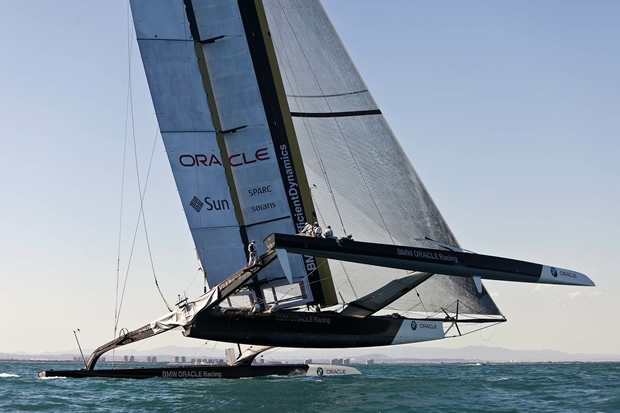
Wings at the World Yacht Racing Forum
One session not to be missed at the Design & Technology Symposium earlier this week was the session on ‘Overcoming Challenges to Produce A Winning Multihull Design for America’s Cup 34’.
For this the speakers were Vincent Lauriot Prevost (the LP in VPLP), engineer Andrea Avaldi of ABS Advanced Structural Design, currently working for Artemis Racing, C-Class guru Steve Clark and BMW Oracle Racing’s Design Director, Manolo Ruiz de Elvira, ably moderated by our esteemed colleague, Dobbs Davis. Sadly we missed Vincent Lauriot Prevost’s presentation, but managed to catch the rest...
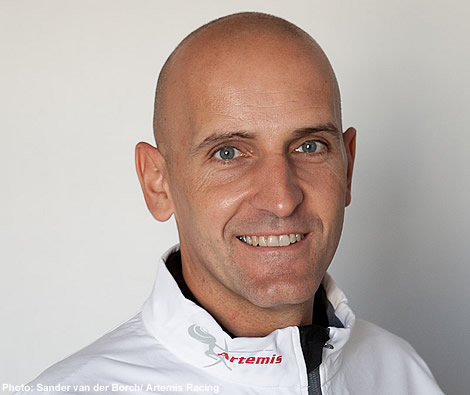
Andrea Avaldi was discussing the structures of solid wing rigs when we arrived and was making the interesting comparison between the wholly different load cases of an aircraft wing and a solid wing sail. The former typically faces 500-800 kg/m2 of load compared to just 10-20 kg/m2 for an AC72. So a factor of 40x less...
We hold solid wing sails up with rigging, the airplane equivalent of the Sopwith Camel. Modern aircraft wings are essentially cantilever beams, the equivalent of an unstayed mast. While this might be practical on a trimaran, it seems unlikely it would be on a catamaran where the wing would be stepped on the already structurally complex middle of the main crossbeam.
“We are going to go in a place with design which hasn’t been explored before,” said Avaldi. “Things can break, we are asked to push the design, because we are talking about the America’s Cup. For sure we will have problems, but problems in a healthy design process are always welcome. You obviously need to limit the amount of failure in your design, but the way you deal with failure will make your design successful or not.”
He then handed over to the Little America’s Cup legend that is American Steve Clark, who aside from his decades in the C-Class, winning the Little America's Cup in 1996 and defending in 2003 aboard Cogito, has also spent years in the A-Class, International Canoes, etc had a lengthy spell ran Vanguard Sailboats in Rhode Island and comes with an encyclopaedic knowledge of sailboats.
We have published many interviews with Clark in the past and on this occasion he ran the delegates through how C-Class design has evolved, the latest boats and what they have tried to achieve (read his thoughts about the last Little America's Cup here)
“Downwind the boats are pretty efficient doing about 16 knots - the drag goes up quite a bit before that. The standard downwind sailing technique is to camber the wing up and get a lot of power in the wing and then fly the hull and then drive it down as hard as we could and still keep the flow attached and keep the boat powered up.
“In very light airs, even in 3-4 knots they are really kind of magical. They will sail in conditions most other boats just float around in.”
For AC crews worried about the prospect of taking AC45s or AC72s out in big breeze, Clark offered reassurance: “We do sail when it blows hard, but the wings are so clean that when you flatten them out, you don’t have to reef because the wing has such a long drag co-efficient when you take the camber out of it, as long as you can go upwind, you can withstand almost anything. I have been out in well over 30 knots - it is not a lot of fun but as long as you can keep going upwind you’re fine. You don’t want to turn the corner and start going downwind, because you start going into the backs of waves, etc.”
Recently Clark has been experimenting with foils with a view to addressing the inherent pitching issues catamarans have – in particular adjustable T-foil rudders and curved asymmetric daggerboard which can be angled inwards, providing some vertical lift. On his latest C-cat the daggerboards’ cant angle was 20-40 degrees, providing around 75-80kg of lift in the most vertical position.
A rudder T-foil, as is the case on both Moths and International 14s, can be used to alter the fore and aft attitude of the entire boat relative to the water and so this includes altering the pitch of the daggerboard – a more bow-up trim equals more lift from the foil.
Clark showed a picture of one of the Canadian C-Class cats launched... “You can make mistakes. Here they messed up the rudder control and the boat was sailing with a more bow-up angle and the weather daggerboard had fallen down – they were hit by the puff, eased and bore away and all of a sudden the boat jumped in the air...”
Prior to the America’s Cup, Fred Eaton’s Canadian team also experimented with Off Yer Rocker, a sistership to their 2007 Little America’s Cup winner Alpha, only fitted with two sets of Moth foils in an attempt to get their C-Class airborne. The foils did succeed in getting the cat airborne, but surprisingly it proved substantially slower than the non-foiler.
“Usually people who do this do something else wrong, but they didn’t - it was the same hulls and the same wing,” said Clark. “It was like two Moths tied together. Why this boat never went all that fast, we believe was because they put too big foils on into it and it foiled too soon. The induced drag from the four foils was never that much better than the lift to drag ratio of the hull in Archimedes mode.”
Clark went on to show pre-destruction images of his latest C-Class Aethon (in fact twice destroyed, once when she capsized when sailing with his 1996 winner Cogito’s rig during this year’s Little America’s Cup - see the video - and subsequently when they were out sailing with one of the Canadian team’s wings against the 2010 LAC winner Canaan and the Aethon platform folded up, possibly due to damage to the main beam from the previous capsize).
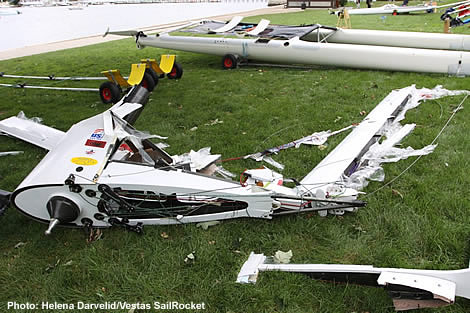
“What we tried to accomplish with this design was - these boats go about 20-22 knots all the time in about 10 knots of breeze and that is pretty early in the day to be going maximum speed," Clark continued. "It is well proven that as you go faster seakeeping and spray drag play a larger and larger role. In fact it has been proven with seaplane floats that a 20 knot spray drag is a really big deal and you have to get the boat out of the water. A long skinny hull is antithetical to planning, but it is really necessary to get going that fast to begin with. So we decided to push forward with the banana board project and put T-foil rudders on it.
“Going upwind on the leeward hull, the rudders are now deep enough so that the T-foils don’t exit the surface when you are flying the hull at normal speed. There is less rocker in the hull. The ends are fuller. We tried to learn the lessons from the A-Class with what they call ‘wave piercers’, but which are really just high water plane inertia shapes, not as focussed on reducing wetted surface but trying to manage the dynamics of the boat at speed with foil systems and let the hull do what the hull does best.”
With the T-foil rudder and curved, canting asymmetric daggerboard it is possible to tune the boat to wave conditions so that it runs very cleanly. Clark emphasises that the lifting daggerboards are not to get the hull airborne, but to reduce drag and reduce pitching. However there have been times when the boat has lifted out. “The boat is not stable in the air,” Clark warns. “If you sail upwind with too much daggerboard tip, you will lift off. It gets distressing when it happens because you are not in control and you don’t know how you are going to come back down. We have gained some experience with that so we are not quite as panicked as we were when we started. We definitely weren’t trying to get foil-borne.”
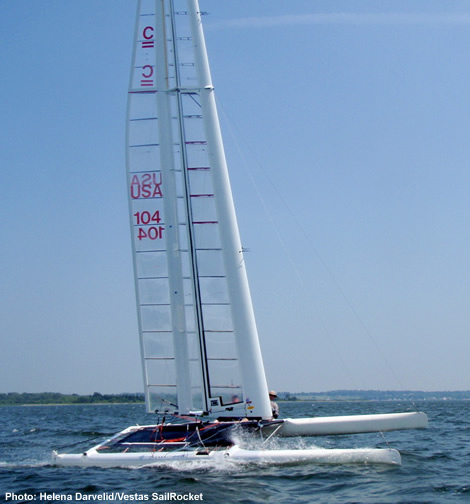
By taking these steps the objective of Aethon was also to increase the top speed from 20 knots to around 25, which they succeeded in doing. “That is where we think the next step in performance is – to drive the boat through the water faster, pull the apparent wind further forwards, to be able to operate the wing at a lower lift co-efficient, and reduce the induced drag penalty from having all the high lift elements on the wing.”
Clark clicked up an enticing diagram showing the lift co-efficients for different angles of attack for different rig types – unarig, sloop, single, two and three element wings. With a faster boat, like an AC45 or an AC72 or USA 17 Clark said the apparent wind angle would be 18-20 degrees a lot of the time while they were still “low 20s to the 30s downwind. So we still need that second slot, and the high lift associated with it.”
He then showed different images of wings from the last 20-30 years, from the 1980s vintage Patient Lady’s X wing, to the first complex three element rig developed by Australian Little America’s Cup winner Lindsay Cunningham. “Essentially there is a slot between each of the elements, each element has a little trim tab on it - very high lift coefficients are available from this, low speed great lift, but with more slots the more drag you get – not very fast upwind but watch out downwind.
“Lindsay’s control systems were elaborate. No one really understood what was going on with them! And they weren’t self tacking like the Patient Lady wings which tack and gybe with no more trouble than a soft sail.”
A significant development with the Cogito rig, and C-Class wings since, has been in the way they twist in order to accommodate wind shear. On modern C-Class wings twist can be put into the wing’s front and rear elements.
“We have tried at various times to design wings that would allow us to adapt the twist configuration for the given day and then someone says ‘how are you going to measure that?’ So we have gone with a linear twist system.”
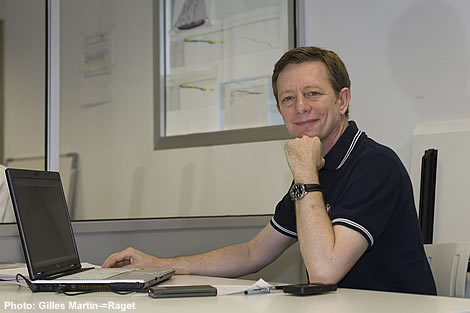
Next up was naval architect Manolo Ruiz de Elvira, who worked for Alinghi for the 31st and 32nd America’s Cups before jumping ship to go to the opposition prior to the 33rd.
De Elvira talked about making the transition from being a monohull designer to designing multihulls. “There is something radically different in the way of sailing and the way we design these type of boats, but there is also something common – it is naval architecture and sailing. It is looking with a different view,” he said.
He went on to tell us about BMW Oracle Racing’s 33rd America’s Cup winning trimaran USA17 with its solid wing rig and monster 700sqm genniker.
“The main reason for the wing was that we needed more power and there is a limited amount of sail area you can handle and sails stretch, the loads are huge and incredibly difficult to handle. What we looked for in the wing was getting more driving force. At the same time we wanted to achieve that with less air drag in general. We tried to keep the weight to the minimum possible in order to fly a hull. Also in terms of handling - it is very different how these boats move in waves when they have one hull in the water compared to when there are two of them.”
USA 17 was just over 27m long and 25m wide and de Elvira revealed she weighed about 15 tonnes, slightly more than Alinghi 5, but not as much as they thought, he believes.
“The main difference [versus a monohull] is the apparent wind angle - downwind in good breeze you go beyond 30° but most of the time you stay between 12 and 30°. We are normally sailing at 5-6° less apparent upwind than a monohull and a lot more downwind.”
De Elvira stressed the design principles were the same as any sailing yacht, except that “the points where we apply some of the forces are in different positions. Other than that we are still dealing with the same aero and hydro part.”
He proceeded to highlight the differences between the AC33 boat, the Alinghi 5 cat and their trimaran. “With boats, righting moment and how much power can you take and how much sail area you have to deliver that power - they are the main factors. Here it is mostly beam and displacement that determine the righting moment. The cat option that makes for a lighter, more narrow boat, obviously with less righting moment, but also requires less power to fly a hull. That is a significant reduction in drag and really performs well in light air, but is more limited in how much power it can deliver, so in medium breeze it would be a slight disadvantage.
“On the other hand the trimaran is a wider boat and we were a bit heavier [than Alinghi 5]. Basically we needed a bit more power, a couple of knots more to fly a hull and we have a bit more hydro drag because of the extra righting moment. As soon as you fly a hull it is good, the boat is performing well and that finally showed.”
Elvira said shape control was one of the fantastic aspects of the wing compared to a soft sail, but induced drag represented a larger component of total drag. “You can really have close to whatever shape you want to have with the limitations of the configuration and that is really difficult to do with a soft sail. And you have a fantastic control of what you can do span-wise, with lift distribution, so you can act on the induced drag. Also something really important is that you can work very well on controlling the sail induced pitch moment which in a multihull is quite critical.”
USA 17 started test sailing with a soft sail rig and BMW Oracle Racing were able to get some good data on the different load cases between the softsail and wing. For example the soft sail had a 25 tonne main sheet load, compared with just 2.5 tonnes on the wing's equivalent. De Elvira also pointed out that due to the enormous loads it was hard to make the mainsail strong enough without being excessively heavy.
The USA 17 wing had two elements and the front element was not twisting, so it offered a lower lift co-efficient than the C-Class rigs, Steve Clark had been describing earlier. However they could create twist via the flaps in the rear element. “We had nine individual flaps. They were linked together, but there were actuators for six of them, so you could change the camber along the span, but it was a soft transition.” De Elvira said the principle reason they didn’t go for a three element rig were time constraints.
The engineering challenge of creating their wing was obviously new to them and De Elvira said a considerable amount of finite element analysis went into its creation to remove all excess weight.
“Construction was a nightmare. It was a different type of construction to what the boat builders were used to, but they did a really amazing job. We ended up having the wing built in the time respected. We had different problems in different elements and fairings and the main spar - it was a sum of complications that had to be solved along the way before we got the wing to San Diego.”
Returning to the difference between monohull and multihull design, de Elvira said that pitch was something of a new consideration. “Pitch moment is something we take for granted in a monohulls, but here [with multihulls] it is something you have to look at really carefully. You don’t want to pitchpole and it also has an influence in performance. Windage has to become an obsession. Otherwise it is the same thing.”
He went on to look at the AC45 and 72. The wing on the 45 is a similar two element affair to USA 17, with five crew and designed to get AC teams up to speed on racing with wings. They are designed to operate over a range of 5-30 knots. “These boats are going to be fully powered up in 8-9 knots of wind, so you will be depowering at 13 knots the same as you would at 30.”
“I am as curious as everyone else about how this will develop,” he concluded.
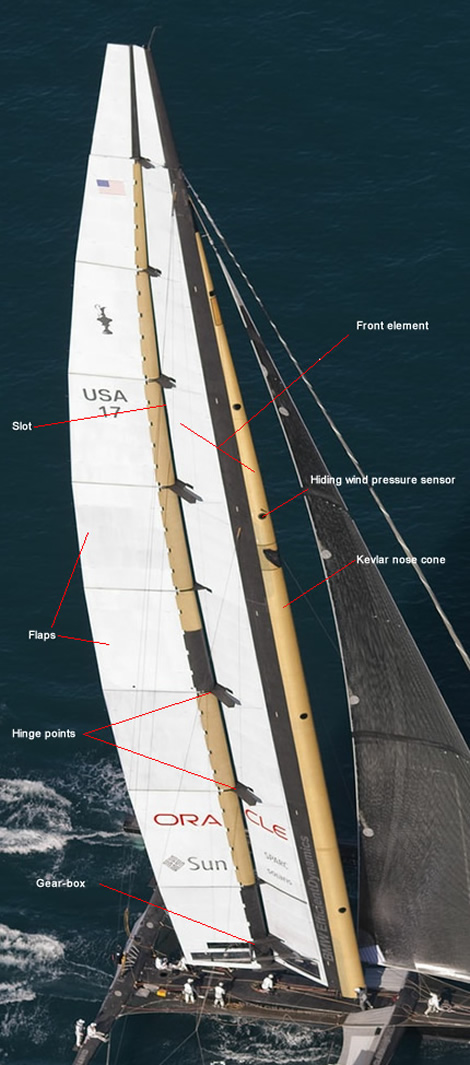









Latest Comments
898568 21/12/2010 - 11:17
Hello to TDS's members, I was involved in C-Class design during 1990-1991 in France and carried out also extensive wind tunnel campaigns on to assess real lift / drag performances of slotted wings over these boats. We tested single-slotted and double-slotted wings. To give additional details : > an highly well tuned catamaran soft sail reaches a max CL of around 1.4 to 1.5 (depending on the effective aspect ratio, sheet tension....) > C-Class wings were from CL = 2.25 to 2.44 with less gaps than it was formerly believed between single and double slotted...Low figures due to low Reynolds number circulating flows. A bigger significant leap in CL needed a design breakthrough coming from fundamental physics of high-lift. We succeeded in reaching CL max = 2.62. If double slotted C-Class wings were penalized, this was mainly due to the complex external double-stagged levers, conecting rods, cams, and old profiles used on Yellow Pages. Anyway, the much higher AC 72's Reynolds number will re-distribute playing cards. About induced drag, the devil is again in the detail as the geometric aspect ratio is rule-frozen and twist managment will be truly a crucial matter. I will simply add about the failure of the foiling Moth-Style "Off Yer Rockers" something that has been guessed by Steve Killing himself...Simply, if you lift the whole of a catamaran planform at each edge, the equivalent virtual roll axis move sidewards from the downwind hull towards the cat's symmetry x'Ox axis and the effective righting moment drastically falls... R.Laval-Jeantet, PhDAdd a comment - Members log in